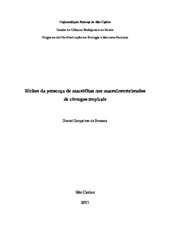| dc.contributor.author | Fonseca, Daniel Gonçalves da | |
| dc.date.accessioned | 2016-06-02T19:31:59Z | |
| dc.date.available | 2012-01-10 | |
| dc.date.available | 2016-06-02T19:31:59Z | |
| dc.date.issued | 2011-04-08 | |
| dc.identifier.citation | FONSECA, Daniel Gonçalves da. Efeitos da presença de macrófitas aquáticas nos macroinvertebrados de córregos tropicais. 2011. 81 f. Dissertação (Mestrado em Ciências Biológicas) - Universidade Federal de São Carlos, São Carlos, 2011. | por |
| dc.identifier.uri | https://repositorio.ufscar.br/handle/ufscar/2049 | |
| dc.description.abstract | The riparian forest deforestation by pasture activities allows greater solar incidence on the streams bed. The high input of light favours the development of aquatic macrophytes, which also contributing with the high primary production rate and are important substrate for aquatic organisms. This substrate generates stability subunities and complex microhabitats which are used as refugee, places and feeding source and interfere in the trophic relations in the streams. Benthic macroinvertebrates can be affected in several ways by fish (predators) through direct effects (feeding) or indirect effects (predation risk, bio-perturbation, trophic links). However, the complexity offered by the macrophytes can influence the trophic interactions between fish and the macroinvertebrates, decreasing the predation pressure and allowing the coexistence among these organisms. The objective of this study was to evaluate the macrophyte influence on the aquatic communities. With the purpose of facilitate the understanding, the study was divided in two chapters: (1) It compared the macroinvertebrate assemblages present in sites with or without macrophytes in three different streams; (2) It evaluated the aquatic macrophyte effects on the colonization of macroinvertebrate communities and on the predation interaction between macroinvertebrates and fish, using an experiment with exclusion cages in two streams. The results allow a better understanding of the functional processes in the structure of the streams, providing knowledge about the human interaction effects on the functioning of these systems. | eng |
| dc.description.sponsorship | Universidade Federal de Minas Gerais | |
| dc.format | application/pdf | por |
| dc.language | por | por |
| dc.publisher | Universidade Federal de São Carlos | por |
| dc.rights | Acesso Aberto | por |
| dc.subject | Ecologia | por |
| dc.subject | Macrófitas aquáticas | por |
| dc.subject | Peixes | por |
| dc.subject | Comunidades | por |
| dc.subject | Communities | eng |
| dc.subject | Aquatic macrophytes | eng |
| dc.subject | Macroinvertebrates | eng |
| dc.subject | Fishes | eng |
| dc.subject | Predation | eng |
| dc.subject | Pasture streams | eng |
| dc.title | Efeitos da presença de macrófitas aquáticas nos macroinvertebrados de córregos tropicais | por |
| dc.type | Dissertação | por |
| dc.contributor.advisor1 | Tanaka, Marcel Okamoto | |
| dc.contributor.advisor1Lattes | http://lattes.cnpq.br/2768658925977757 | por |
| dc.description.resumo | O desmatamento das matas ciliares realizado por atividades de pastagens possibilita maior incidência solar sobre o leito dos córregos. A alta entrada de luz favorece o desenvolvimento de bancos de macrófitas, que além de contribuírem com alta taxa de produção primária são importante substrato para os organismos aquáticos. Esse substrato gera subunidades de estabilidade e microhabitats complexos que são utilizados como refúgio, local e fonte de alimentação e interferem nas relações tróficas dentro dos riachos. Macroinvertebrados bentônicos podem ser afetados de diversas formas pela presença de peixes (predadores), seja através de efeitos tróficos diretos (alimentação) ou de efeitos indiretos (ameaça de predação, bioperturbação, ligações tróficas). No entanto, a complexidade fornecida pelas macrófitas pode influenciar as interações tróficas entre peixes e macroinvertebrados, diminuindo a pressão de predação e permitindo a coexistência entre esses organismos. O objetivo do estudo foi avaliar a influência das macrófitas aquáticas nas comunidades de macroinvertebrados aquáticos. Na intenção de facilitar a compreensão, o estudo foi dividido em dois capítulos: (1) Comparou as comunidades de macroinvertebrados presentes em locais com e sem macrófitas em três diferentes riachos; (2) Avaliou o efeito das macrófitas aquáticas na colonização da assembléia de macroinvertebrados e na interação de predação entre macroinvertebrados e peixes, usando um experimento com gaiolas de exclusão em dois riachos. Os resultados permitem um melhor entendimento dos processos funcionais e estruturais de riachos, fornecendo conhecimento dos efeitos de alterações humanas no funcionamento desses sistemas. | por |
| dc.publisher.country | BR | por |
| dc.publisher.initials | UFSCar | por |
| dc.publisher.program | Programa de Pós-Graduação em Ecologia e Recursos Naturais - PPGERN | por |
| dc.subject.cnpq | CIENCIAS BIOLOGICAS::ECOLOGIA | por |
| dc.contributor.authorlattes | http://lattes.cnpq.br/7623315609149062 | por |
